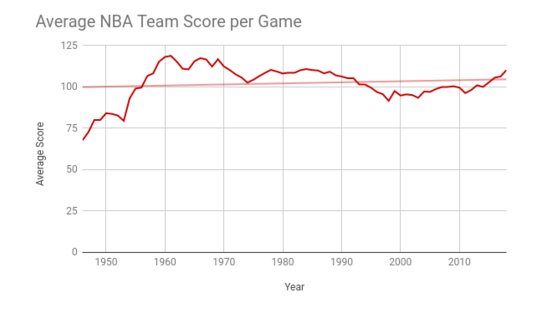ACCUSATION: Is NBA scoring really at an all-time high?
By Andrew Carlson, Staff Editor
Google “NBA scoring,” and you’ll find countless game scores with winning teams consistently scoring well over 100 points per game, along with dozens of articles discussing this huge increase in NBA scoring. In fact, as I’m writing this article, the Golden State Warriors just set a new NBA record for the most points scored in the first quarter of a game (51). Everywhere you look, NBA scoring seems to be soaring through the roof. In a recent Instagram poll I posed, 75% of those who answered said that they believe that NBA scoring is higher than ever before. But is it really?
I spent hours researching and recording NBA statistics, and I expected to find a drastic rise in scoring trends over the past decade, but I was surprised by what I found.
 As the graph shows, scoring in the NBA peaked between 1960 and 1970, then dropped between 1995 and 2005, and is currently on an average scoring level similar to the 1980s. So far this season, NBA teams are averaging 110.3 points per game, which is only the 14th the highest ever on record. If this is the case, why is it that so many people are claiming that the NBA is more high-scoring than ever before?
As the graph shows, scoring in the NBA peaked between 1960 and 1970, then dropped between 1995 and 2005, and is currently on an average scoring level similar to the 1980s. So far this season, NBA teams are averaging 110.3 points per game, which is only the 14th the highest ever on record. If this is the case, why is it that so many people are claiming that the NBA is more high-scoring than ever before?
I believe that the answer lies in psychology and math.
While scoring is not at an all-time high, it is the highest seen in the last two to three decades, which partially explains why many believe that scoring has exploded so greatly. For some, it is simply a matter of not being alive during the “big man” era of the 60s and 70s (where scoring was dominated by the tallest and strongest players in the league), so this scoring outburst is all they’ve ever known. But one of the main reasons for the popular scoring belief is the dominance of the three-point shot across basketball.
When the three-point line was first established in 1979, it was viewed as a gimmick, a publicity stunt designed to gain a wider audience; no one foresaw it becoming a prevalent source of offense. In 1984, NBA teams were averaging only 2.4 three-point attempts a game. On January 3, 2019, James Harden of the Houston Rockets single-handedly put up 23 three-point attempts. The three-pointer, mathematically, is a more efficient shot for players to take. According to shottracker.com, 100 mid-range jumpers will provide 79 points on average, while 100 above-the-break 3s would provide 105. By changing shot selection, NBA teams can increase their offensive efficiency.
Accompanying this increased frequency of deep-range shots is a psychological effect on fans. According to the availability heuristic of psychology, humans make judgments about the likelihood of an event based on how easily an example of the event comes to mind. For example, one might not fly on an airplane due to a recent plane crash on the news. In the case of basketball, a three-point shot is much more memorable than a mid-range jumpshot, and the prevalence of extraordinary three-point shooting teams such as the Warriors and Rockets have essentially given fans a false sense of high scoring. The dominance of the three pointer over its midrange counterpart has led us to believe that scoring is higher than it’s ever been.
Another contributing factor in the high scoring of the NBA is the pace of the game. The era of basketball from 1995 to 2011-2012 was characterized by a slower pace of basketball (about 91 possessions per 48 minutes). So far this season, according to basketballreference.com, the league pace is 99.5 possessions per 48 minutes, the highest since 1988. This faster pace, in contrast to previous years, gives the illusion of more scoring, since logically, the more possessions a team has, the more chances they can capitalize on to score. Yet, when one looks deeper into the statistics, the fastest era of basketball occurred in the 1970s, with the record of 107.8 possessions per game belonging to the 1973-1974 season. Despite popular belief, the NBA is not at an all-time scoring high or playing at breakneck pace. Granted, basketball is increasing in scoring and pace compared to the last decade, and may one day surpass the 60s and 70s in terms of offensive firepower, but at this point in time, we have fallen victim to misconceptions and exaggerations.

